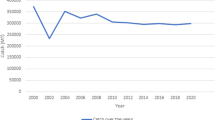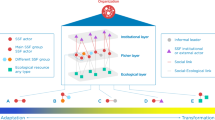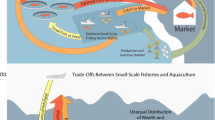Abstract
Functionally connected marine conservation areas are widely recognized as a cornerstone for successful biodiversity conservation outcomes and small-scale fisheries livelihoods. Incorporating fish species movement into fisheries community-based managed areas can catalyse greater conservation and socioeconomic benefits. However, significant gaps exist in aligning small-scale fisheries management with fish connectivity or movement patterns, which can optimize benefits along coral reef systems and associated coastal small-scale fisheries. Here we describe a translational framework that integrates evidence-based connectivity conservation into small-scale fisheries in community-based managed area settings while considering cumulative benefits over time and space to ensure long-term socioeconomic and environmental benefits across such systems.
This is a preview of subscription content, access via your institution
Access options
Access Nature and 54 other Nature Portfolio journals
Get Nature+, our best-value online-access subscription
27,99 € / 30 days
cancel any time
Subscribe to this journal
Receive 12 digital issues and online access to articles
118,99 € per year
only 9,92 € per issue
Buy this article
- Purchase on SpringerLink
- Instant access to full article PDF
Prices may be subject to local taxes which are calculated during checkout




Similar content being viewed by others
References
Leslie, H. M. & McLeod, K. L. Confronting the challenges of implementing marine ecosystem‐based management. Front. Ecol. Environ. 5, 540–548 (2007).
Hilty, J. et al. Guidelines for Conserving Connectivity Through Ecological Networks and Corridors (IUCN, 2020).
Fontoura, L. et al. Protecting connectivity promotes successful biodiversity and fisheries conservation. Science 375, 336–340 (2022).
Riordan‐Short, E., Pither, R. & Pither, J. Four steps to strengthen connectivity modeling. Ecography 2023, e06766 (2023).
Beger, M. et al. Demystifying ecological connectivity for actionable spatial conservation planning. Trends Ecol. Evol. 37, 1079–1091 (2022).
Knight, A. T. et al. Knowing but not doing: selecting priority conservation areas and the research–implementation gap. Conserv. Biol. 22, 610–617 (2008).
Oppler, G., Hilty, J. A., Laur, A. T. & Tabor, G. Connectivity conservation: the time is now. Parks Steward. Forum 37, 3 (2021).
Balbar, A. C. & Metaxas, A. The current application of ecological connectivity in the design of marine protected areas. Glob. Ecol. Conserv. 17, e00569 (2019).
Harrison, H. B., Bode, M., Williamson, D. H., Berumen, M. L. & Jones, G. P. A connectivity portfolio effect stabilizes marine reserve performance. Proc. Natl Acad. Sci. USA 117, 25595–25600 (2020).
Caselle, J., Carr, M. & White, W. Northern Channel Islands: Connectivity Across a Network of Marine Protected Areas Contributes to Positive Population and Ecosystem Consequences (IUCN Guidelines, 2020).
Hamilton, R. J. et al. Larval dispersal and fishing pressure influence recruitment in a coral reef fishery. J. Appl. Ecol. 58, 2924–2935 (2021).
Almany, G. R. et al. Dispersal of grouper larvae drives local resource sharing in a coral reef fishery. Curr. Biol. 23, 626–630 (2013).
Goetze, J. S. et al. Increased connectivity and depth improve the effectiveness of marine reserves. Glob. Change Biol. 27, 3432–3447 (2021).
Muallil, R. N. et al. Effectiveness of small locally-managed marine protected areas for coral reef fisheries management in the Philippines. Ocean Coast. Manage. 179, 104831 (2019).
Smallhorn-West, P. et al. The Fisheries Co-Management Guidebook: Emerging Research for the Effective Management of Small-Scale Fisheries (WorldFish, 2023).
Jupiter, S., Cohen, P., Weeks, R., Tawake, A. & Govan, H. Locally-managed marine areas: multiple objectives and diverse strategies. Pac. Conserv. Biol. 20, 165–179 (2014).
Jupiter, S. D., Weeks, R., Jenkins, A. P., Egli, D. P. & Cakacaka, A. Effects of a single intensive harvest event on fish populations inside a customary marine closure. Coral Reefs 31, 321–334 (2012).
Jupiter, S. D. & Egli, D. P. Ecosystem‐based management in Fiji: successes and challenges after five years of implementation. J. Mar. Sci. 2011, 940765 (2011).
Buston, P. M. & D’Aloia, C. C. Marine ecology: reaping the benefits of local dispersal. Curr. Biol. 23, R351–R353 (2013).
Welden, E. A., Chausson, A. & Melanidis, M. S. Leveraging nature‐based solutions for transformation: reconnecting people and nature. People Nat. 3, 966–977 (2021).
Green, A. L. et al. Larval dispersal and movement patterns of coral reef fishes, and implications for marine reserve network design. Biol. Rev. 90, 1215–1247 (2015).
Bode, M. et al. Successful validation of a larval dispersal model using genetic parentage data. PLoS Biol. 17, e3000380 (2019).
Teh, L. S. L., Teh, L. C. L. & Sumaila, U. R. A global estimate of the number of coral reef fishers. PLoS ONE 8, e65397 (2013).
Abesamis, R. A. et al. Reef-fish larval dispersal patterns validate no-take marine reserve network connectivity that links human communities. Coral Reefs 36, 791–801 (2017).
Treml, E. A., Fidelman, P. I. J., Kininmonth, S., Ekstrom, J. A. & Bodin, Ö. Analyzing the (mis)fit between the institutional and ecological networks of the Indo-West Pacific. Glob. Environ. Change 31, 263–271 (2015).
Abesamis, R. A. & Russ, G. R. Density‐dependent spillover from a marine reserve: long‐term evidence. Ecol. Appl. 15, 1798–1812 (2005).
Bernatchez, L., Ferchaud, A.-L., Berger, C. S., Venney, C. J. & Xuereb, A. Genomics for monitoring and understanding species responses to global climate change. Nat. Rev. Genet. 25, 165–183 (2024).
Bodin, Ö. Collaborative environmental governance: achieving collective action in social-ecological systems. Science 357, eaan1114 (2017).
Barnes, M. L. et al. Social–ecological alignment and ecological conditions in coral reefs. Nat. Commun. 10, 2039 (2019).
Cinner, J. E. & McClanahan, T. R. A sea change on the African coast? Preliminary social and ecological outcomes of a governance transformation in Kenyan fisheries. Glob. Environ. Change 30, 133–139 (2015).
Hamilton, R. J., Potuku, T. & Montambault, J. R. Community-based conservation results in the recovery of reef fish spawning aggregations in the Coral Triangle. Biol. Conserv. 144, 1850–1858 (2011).
Foale, S. & Manele, B. Social and political barriers to the use of marine protected areas for conservation and fishery management in Melanesia. Asia Pac. Viewp. 45, 373–386 (2004).
Bitoun, R. E. et al. A methodological framework for capturing marine small-scale fisheries’ contributions to the sustainable development goals. Sustain. Sci. 19, 1119–1137 (2024).
Esmail, N. et al. What’s on the horizon for community-based conservation? Emerging threats and opportunities. Trends Ecol. Evol. 38, 666–680 (2023).
Kawaka, J. A. et al. Developing locally managed marine areas: lessons learnt from Kenya. Ocean Coast. Manage. 135, 1–10 (2017).
Mayol, T. L. Madagascar’s nascent locally managed marine area network. Madag. Conserv. Dev. 8, 91–95 (2013).
Pomeroy, R. S. et al. Guidebook for Evaluating Fisheries Co-management Effectiveness (FAO, 2022).
Brown, K. T., Southgate, P. C., Hewavitharane, C. A. & Lal, M. M. Saving the sea cucumbers: using population genomic tools to inform fishery and conservation management of the Fijian sandfish Holothuria (Metriatyla) scabra. PLoS ONE 17, e0274245 (2022).
Leis, J. M. Ontogeny of behaviour in larvae of marine demersal fishes. Ichthyol. Res. 57, 325–342 (2010).
de Mitcheson, Y. S. & Colin, P. L. Reef Fish Spawning Aggregations: Biology, Research and Management Vol. 35 (Springer Science & Business Media, 2011).
Waldie, P. A. et al. Restricted grouper reproductive migrations support community-based management. R. Soc. Open Sci. 3, 150694 (2016).
Davies, H. N. et al. Mapping the marine environment through a cross-cultural collaboration. Front. Mar. Sci. 7, 716 (2020).
Hamilton, R., de Mitcheson, Y. S. & Aguilar-Perera, A. in Reef Fish Spawning Aggregations: Biology, Research and Management. (eds de Mitcheson, Y. S. & Colin, P. L.) 331–369 (Springer, 2011).
Prince, J. et al. Spawning potential surveys in Fiji: a new song of change for small‐scale fisheries in the Pacific. Conserv. Sci. Pract. 3, e273 (2021).
McClanahan, T. R., Marnane, M. J., Cinner, J. E. & Kiene, W. E. A comparison of marine protected areas and alternative approaches to coral-reef management. Curr. Biol. 16, 1408–1413 (2006).
Bladon, A. J., Mohammed, E. Y., Ali, L. & Milner-Gulland, E. J. Developing a frame of reference for fisheries management and conservation interventions. Fish. Res. 208, 296–308 (2018).
Medoff, S., Lynham, J. & Raynor, J. Spillover benefits from the world’s largest fully protected MPA. Science 378, 313–316 (2022).
Cheung, W. W. L. et al. Rebuilding fish biomass for the world’s marine ecoregions under climate change. Glob. Change Biol. 28, 6254–6267 (2022).
Barceló, C., White, J. W., Botsford, L. W. & Hastings, A. Projecting the timescale of initial increase in fishery yield after implementation of marine protected areas. ICES J. Mar. Sci. 78, 1860–1871 (2021).
Coleman, M. A. et al. Anticipating changes to future connectivity within a network of marine protected areas. Glob. Change Biol. 23, 3533–3542 (2017).
Davis, R. A. & Hanich, Q. Transparency in fisheries conservation and management measures. Mar. Policy 136, 104088 (2022).
Carruthers, T. R. et al. Method evaluation and risk assessment: a framework for evaluating management strategies for data‐limited fisheries. Fish Fish. 24, 279–296 (2023).
Recognising and Reporting Other Effective Area‐Based Conservation Measures (WCPA, 2019).
Voss, R. et al. Quantifying the benefits of spatial fisheries management—an ecological–economic optimization approach. Ecol. Modell. 385, 165–172 (2018).
Harding, S., Marama, K., Breckwoldt, A., Matairakula, U. & Fache, E. Marine resources and their value in Kadavu, Fiji. Ambio 51, 2414–2430 (2022).
Robertson, T. et al. Locally managed marine areas: implications for socio-economic impacts in Kadavu, Fiji. Mar. Policy 117, 103950 (2020).
O’Garra, T. et al. National-level evaluation of a community-based marine management initiative. Nat. Sustain. 6, 908–918 (2023).
Garcia, S. M. et al. OECMs in marine capture fisheries: key implementation issues of governance, management, and biodiversity. Front. Mar. Sci. 9, 920051 (2022).
Jagadish, A. et al. Scaling Indigenous-led natural resource management. Glob. Environ. Change 84, 102799 (2024).
Gurney, G. G. et al. Biodiversity needs every tool in the box: use OECMs. Nature https://doi.org/10.1038/d41586-021-02041-4 (2021).
Bremer, L. L. et al. Embedding local values in payments for ecosystem services for transformative change. Curr. Opin. Environ. Sustain. 64, 101354 (2023).
Booth, H. et al. Designing locally-appropriate conservation incentives for small-scale fishers. Biol. Conserv. 277, 109821 (2023).
Bell, J. D. et al. Adaptations to maintain the contributions of small-scale fisheries to food security in the Pacific Islands. Mar. Policy 88, 303–314 (2018).
Saint-Amand, A., Lambrechts, J. & Hanert, E. Biophysical models resolution affects coral connectivity estimates. Sci. Rep. 13, 9414 (2023).
Reed, J. et al. The extent and distribution of joint conservation–development funding in the tropics. One Earth 3, 753–762 (2020).
Fariss, B. et al. Catalyzing success in community‐based conservation. Conserv. Biol. 37, e13973 (2023).
Ripple, K. J. et al. Enabling usable science takes a community: using our roles as funders to catalyze change. PLoS Biol. 22, e3002675 (2024).
McClanahan, T., Muthiga, N. A. & Abunge, C. A. Establishment of community managed fisheries’ closures in Kenya: early evolution of the tengefu movement. Coast. Manage. 44, 1–20 (2016).
Cinner, J. E. et al. Vulnerability of coastal communities to key impacts of climate change on coral reef fisheries. Glob. Environ. Change 22, 12–20 (2012).
Barr, R., Bruner, A. & Edwards, S. Fisheries improvement projects and small-scale fisheries: the need for a modified approach. Mar. Policy 105, 109–115 (2019).
Acknowledgements
L.F. was supported by a Macquarie University Research Fellowship (MQRF0001183-2022). V.H. was supported through a co-funded fellowship with Macquarie University and The Western Indian Ocean Marine Science Association. Ooid Scientific helped with the graphical design of Fig. 1.
Author information
Authors and Affiliations
Contributions
L.F., J.M., A.T., B.S., V.H. and A.S. conceptualized the paper. L.F. and J.M. wrote and revised the first draft and created conceptual frameworks. L.F. designed and edited the figures.
Corresponding authors
Ethics declarations
Competing interests
The authors declare no competing interests.
Peer review
Peer review information
Nature Sustainability thanks Stuart Kininmonth and the other, anonymous, reviewer(s) for their contribution to the peer review of this work.
Additional information
Publisher’s note Springer Nature remains neutral with regard to jurisdictional claims in published maps and institutional affiliations.
Rights and permissions
Springer Nature or its licensor (e.g. a society or other partner) holds exclusive rights to this article under a publishing agreement with the author(s) or other rightsholder(s); author self-archiving of the accepted manuscript version of this article is solely governed by the terms of such publishing agreement and applicable law.
About this article
Cite this article
Fontoura, L., Maina, J., Stow, A. et al. Mainstreaming connectivity science in community-based fisheries management. Nat Sustain 7, 1566–1573 (2024). https://doi.org/10.1038/s41893-024-01443-2
Received:
Accepted:
Published:
Issue Date:
DOI: https://doi.org/10.1038/s41893-024-01443-2



